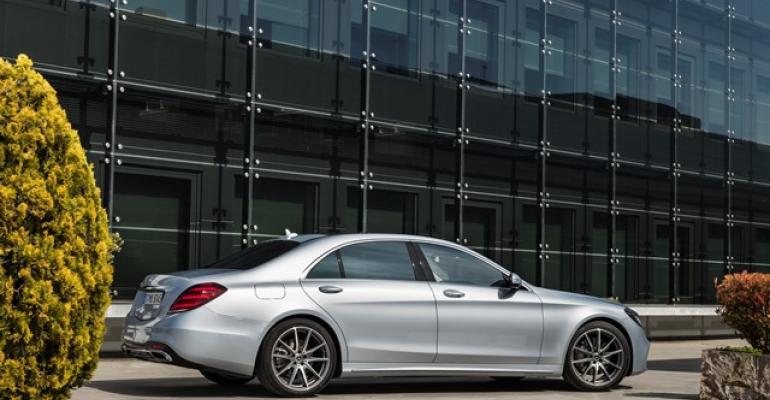The revised ’17 Mercedes-Benz S-Class, unveiled today at the 2017 Shanghai auto show, introduces a new range of inline 6-cyl. engines – the first for the German car maker since it adopted V-6 powerplants in 1997.
The new inline engines, which eventually will find their way into other new Mercedes-Benz models, share their architecture, including their 90-mm bore centre spacing and 0.5L individual cylinder capacity, with the company’s latest 4-cyl. engines and are to be first introduced in diesel form when European sales of the updated S-Class begin later this year.
A gasoline version of the new inline 6-cyl. powerplant, which is supported in the revised S-Class by a 48V electric system that allows it to run both an electric booster compressor an integrated starter generator as part of a mild-hybrid drivetrain strategy aimed at netting greater performance and reduced fuel consumption, will follow in 2018, according to Mercedes.
In the new S350d 4Matic, the turbocharged 3.0L inline 6-cyl. diesel engine, known under the internal codename OM656, develops 207 hp and 442 lb.-ft. (600 Nm) of torque, or some 48 hp and 7 lb.-ft. (10 Nm) less than the turbocharged 3.0L V-6 diesel used by the S350d 4Matic now sold in Europe.
In a higher state of tune in the new S400d 4Matic, however, the new diesel kicks out 335 hp and 516 lb.-ft. (700 Nm) of torque, making it the most powerful diesel-powered car ever offered by Mercedes-Benz.
The new inline 6-cyl. diesel engine comes mated to a standard 9-speed automatic transmission and is claimed to offer fuel savings of up to 7% compared with its V-6 predecessor, with the S350d 4Matic returning 42.8 mpg (5.5 L/100 km) and the S400d 4Matic a claimed 42.0 mpg (5.8 L/100 km) on the European test cycle.
U.S. buyers will have to wait for the introduction of new inline 6-cyl. engines in the revised S-Class, though.
Confirmed for the 2017 North American S-Class is the S450. It runs Mercedes’s older turbocharged 3.0L V-6 gasoline engine that develops 362 hp and 369 lb.-ft. (500 Nm) of torque.
The U.S. lineup for the new-for-2017 S-Class also sees the S550 replaced by the S560 – a model that resurrects one of the most revered model designations ever used by Mercedes-Benz. To be sold in both standard rear- and optional 4Matic all-wheel-drive guises, it receives a detuned version of the AMG-developed twin-turbocharged 4.0L V-8 gasoline engine in place of the twin-turbocharged 4.7L V-8 used in the existing S550, developing an added 13 hp and the same torque as before at 462 hp and 442 lb.-ft.
Farther up the lineup is the updated S63 4Matic. It eschews the twin-turbocharged 5.5L V-8 gasoline engine of its predecessor for the most powerful iteration of AMG’s twin-turbocharged 4.0L V-8 powerplant – as seen in the recently introduced GT R. Power is increased to 603 hp, with torque remaining the same as before at 663 lb.-ft. (900 Nm).
Fitted with the new 9-speed version of AMG’s Speedshift MCT (Multi-Clutch Transmission) and the latest version of Mercedes-AMG’s 4Matic+ all-wheel drive system – as introduced to the E63 4Matic late last year – the 4,398-lb. (1,995-kg) performance sedan is claimed to hit 60 mph (97 km/h) from standstill in just 3.5 seconds, beating its predecessor by 0.4 seconds, while delivering a limited top speed of 155 mph (250 km/h).
Above it is the range-topping S65, which continues to run a twin-turbocharged 6.0L V-12 delivering 621 hp and a stout 737 lb.-ft. (1,000 Nm) of torque.
Further models will be introduced in 2018, including a replacement for the S550e plug-in hybrid – the new S560e. While Mercedes-Benz is holding back on revealing full details, it confirms the successor to today’s S550e, which runs the German automaker’s new M256 designated inline 6-cyl. gasoline engine in combination with an electric motor and 13.3-kWh lithium-ion battery, will provide an electric range of up to 31 miles (50 km).
The facelifted S-Class is visually distinguished from earlier models by some subtle exterior styling changes, including new-look grilles across the range, revised headlamps featuring a new 3-stripe LED daytime running light graphic, restyled bumpers and altered crystal-effect taillamps.
Inside are revised digital instrument and infotainment monitors offering the choice between classic, sporty and progressive themes, new touch-sensitive controls for the infotainment system as well as revised cruise-control actuators within a redesigned steering wheel, a wireless smartphone charging option and new LED lighting offering up to 64 different interior color themes.
In a first, the new S-Class also offers so-called energizing comfort control – an optional system that coordinates the air conditioning, fragrance feature, massaging seats, lighting and sound system to boost comfort and driver well-being across six programs: freshness, warmth, vitality, joy, comfort and training.
Among a wide range of driver aids, the upmarket sedan offers as an option the most advanced autonomous-driving technology offered by Mercedes, the so-called Distronic Active Proximity Control and Active Steer Assist system. It automatically accelerates and brakes the new S-Class sedan within posted speed limits, while providing autonomous steering for periods of up to 30 seconds.
Further advances in the S-Class sedan include an upgraded version Mercedes Magic Body Control system featuring the Curve function that tilts the body nearly 3.0 degrees in corners – as already offered by the S-Class Coupe.





